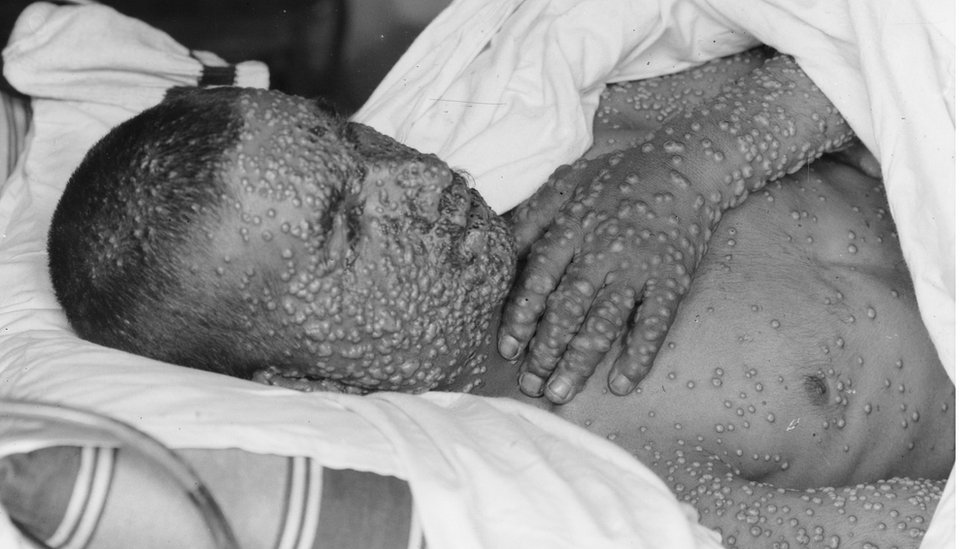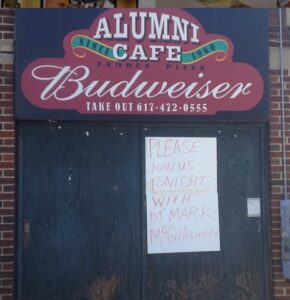Happy birthday John Adams – the greatest political mind in human history, native son of my hometown, and a hero of humanity’s species-old war against the smallpox virus.
Adams chose to go toe to toe against the deadliest virus in mankind’s history … and won! This near-death experience would later help save the fledging United States in its darkest hours during the American Revolution.
Adams was born in a little saltbox-style wood-frame home on what’s now Franklin Street in Quincy, Mass. on October 30, 1735 (or October 19, according to the “old style” Julian calendar in use at the time). The gorgeous little home is still there, part of the Adams National Historical Park.

Adams’s critical roles in the founding of the nation, the advancement of democratic ideals and the creation of constitutional government are well documented.
Less well known is the heroic role he played in the existential struggle for survival against the smallpox virus that plagued the human species since the dawn of time.
Smallpox was an ugly, insidious pathogen far deadlier than any virus known today. It savaged the human biomass for most, if not all, of known history with devastating and tragic results.
Smallpox routinely caused blindness and was most certainly deadly! Its most basic form, “ordinary” smallpox, killed up to 30 percent of the people it infected. Compare that 30 percent mortality rate for smallpox to the less than 1 percent mortality rate for something like Covid-19.
Smallpox was deadly not largely for old people with pre-existing conditions well past human life expectancy. Instead, smallpox often killed children with their whole lives ahead of them, leaving broken families and heartbroken parents in their wake.
Smallpox, even in its mildest forms, was gruesome and painful.
Among many other awful symptoms, smallpox victims busted out in puss-filled sores all over their bodies. These pustules leaked nasty fluid and emitted a terrible rotting odor. These sores covered the face, hands and feet, making it difficult to handle even the most basic human tasks, like eating, walking or going to the bathroom.
Smallpox sores turned to scabs – if victims were lucky enough to live – and these scabs left survivors with scars all over their bodies.

George Washington survived smallpox as a young 19-year-old man and lived with the scars the rest of his life – as did a sizable percentage of the human population for much of our existence.
These pockmarks don’t show up in the romanticized paintings of Washington by Gilbert Stuart or Arnold Friberg, or on the chiseled façade of Mount Rushmore, but the face of the Father of His Country was marred by smallpox scars.
There were even more insidious forms of smallpox with nasty pustules that lived under the skin. This form of the virus rotted a human’s internal organs, which would then leak out of the anus. That’s right. Melted organs dripped out of your ass before you died. These other versions of smallpox came with an almost 100 percent mortality rate.
So smallpox was frightening. And, sadly, it was also quite common.
Humans lived most of our existence under the constant threat of smallpox. Pretty much forever. The Centers for Disease Control reports that evidence of smallpox was found on Egyptian mummies.
Smallpox is not just ancient or colonial history, however. If you’re at least 43 years old you lived in a world with smallpox. The virus killed an estimated 300 million people – in the 20th century alone (!!). The last known case was reported in 1977.
That’s an average nearly 4 million deaths PER YEAR from the smallpox virus from 1900 to 1977 – a period which coincided with two world wars, the 1919 Spanish flu epidemic and a whole host of other deadly viruses and pathogens around the globe.
Somehow, despite all these human tragedies and deadly pathogens, mankind in the 20th century managed to advance culture, improve science, expand the size of the species, explore the heavens, go to work each day, educate our kids in the schoolhouse with real-live teachers and otherwise live normally despite the daily specter of viral death – threats far greater than any you might read about in hysterical headlines today.
American children around my age (born in 1970) were vaccinated for smallpox as babies. We grew up with smallpox scars on our upper arms. A little circle with small dots inside.
All the kids my age had these smallpox vaccination scars. We use to show them to each other in elementary school. Some of us still have those smallpox scars today, though most have faded by age 50.
So smallpox was an ancient but also a fairly recent phenomenon. Billions of people alive today knew the world with smallpox. The United States ended its vaccination program in 1972. The World Health Organization declared the virus eradicated globally in 1980 – 184 years after the first smallpox vaccine was introduced in 1796 (vaccines and cures are not the same thing, contrary to popular opinion today).
But in the time of John Adams, smallpox outbreaks occurred with frightening frequency.
The American colonies were hit by wave after wave of smallpox outbreaks throughout the 17th and 18th centuries – about one epidemic every generation. It was smallpox that wiped out most of the natives, who had no immunity to it, after the Europeans started to arrive en masse to the New World in the 1600s.
Colonists after a couple generations here did not fare much better. Adams’s Boston was a well-known hotspot for smallpox outbreaks, as one of the busiest ports in North America. A real “hotspot” for the virus, not the 8 cases for every 100,000 people (0.008%) that qualifies as a “hotspot” amid the Covid hysteria today.
Boston’s smallpox outbreak of 1721-22 was particularly deadly. More than half the city’s population of 11,000 people contracted the virus, and it killed about 850 people. So nearly 8 percent of the city’s entire population died of smallpox that year. That’s the equivalent of about 56,000 deaths by Boston’s population today.
So this was the deadly smallpox-ravaged world into which John Adams was born 285 years ago today.
But it was a world with a new sign of hope.
By the early 1700s, doctors in Europe, and the few doctors in the American colonies, had discovered the concept of smallpox inoculation (which they credited to Ottoman medical practices). Not vaccination, but inoculation. Think of inoculation as a primitive form of vaccination.
Even this sign of hope in the age-old war against smallpox was fairly gruesome. Doctors would insert a string into the puss of the sores of smallpox victim, then cut a sliver into the skin of a healthy person and insert the puss-soaked string into the opening.
The recipients would get very sick, but MOST would survive and, more importantly, they would enjoy immunity from smallpox for the rest of their lives.
It was very controversial at the time. Famous Boston minister Cotton Mather was an early vocal proponent of inoculation during the 1721 epidemic, which caused him to be savaged by the local citizenry and even the medical community of the time – unable to comprehend why somebody would purposely introduce this horrible disease, death itself, into their bodies.
Boston suffered another smallpox outbreak in 1763-64. And it was amid this deadly outbreak and the controversy over inoculation that 28-year-old John Adams, about to get married and launching his legal career, faced a life-and-death decision:
- Get inoculated, guaranteeing sickness, but gambling on an increased likelihood of survival, and emerge immune from this terrible disease the rest of his life
- Avoid inoculation and hope to get lucky, dodging smallpox by happenstance and avoiding all the pain, suffering and likelihood of death that came with it
Adams chose the former. He chose to get inoculated in the spring of 1764.
Adams survived. But it did not go well. He described the results in graphic detail in a letter to his future wife Abigail. His inoculation included:
“A long and total abstinence from everything in Nature that has any Taste; two long heavy vomits, one heavy cathartick (diarrhea), four and twenty Mercurial and Antimonial Pills, and, three weeks of close confinement to a house (presumably, a hospital).”
Adams suffered badly, certainly worse than the vast numbers of “asymptomatic” (i.e., “not sick”) victims of Covid today.
But he emerged alive and now immune from smallpox, and married Abigail in October of that year. He also proved to be on the right side of history. The 1764 outbreak included one of the first periods of mass inoculation in the history of smallpox, at least in the Americas.
We know the results of the 1764 inoculation from a 1932 report by the Massachusetts Medical Society:
- 4,977 Bostonians were inoculated from smallpox – 46 died (0.9%)
- 669 Bostonians contracted smallpox via infection – 124 died (18.5%)
Due to the success of the smallpox inoculation, hospitals for that purpose were created in Boston at Point Shirley (in Winthrop) and Castle William (now Castle Island).
Still, even for its success, the “cure” for smallpox in 1764 was far deadlier than the actual virus in the headlines today.
Adams, as one of the region’s most prominent citizens, helped popularize inoculation among the local community. Perhaps more importantly, Adams’s experience beating smallpox would influence the outcome of the American Revolution.
Fast forward a decade to 1775. Another deadly smallpox outbreak exploded in Boston and across the colonies that year – just as the first shots of the American Revolution were fired here in Massachusetts.
The epidemic gripped the colonies from 1775 to 1782, basically the entire length of the revolt.
American soldiers, living on close and often squalid quarters, were highly susceptible to smallpox. British soldiers generally enjoyed herd immunity thanks to much greater exposure to the virus among Europeans.
Smallpox, lamented Adams after the American defeat in Quebec at the end of 1775, killed 10 times as many American soldiers than did the British. The ugly virus would continue to ravage Washington’s army on Dorchester Heights, in New York City, in New Jersey, over to Valley Forge, and beyond.
Some 5,000 members of Washington’s army suffered smallpox during the Siege of Boston in 1775-76 – which ended victoriously with the evacuation of the British on March 17, 1776.
Smallpox later gripped the colonial army in Morristown, New Jersey during the winter of 1776-77 and again during that famously deadly winter at Valley Forge, Pennsylvania in 1777-78.
Washington and the budding new nation were in dire straits at Valley Forge. His army got the shit kicked out of it in pretty much ever battle since the Siege of Boston, save the surprise attack at Trenton on Christmas Day 1776.
The Americans were largely a collection of ragtag volunteers. They had little professional training, lack of food and inadequate clothing. They were nearly freezing to death in the North American winter.
And then smallpox gripped their encampments.
Enter John Adams. Influenced by his experience in 1764, he encouraged Washington to have his troops inoculated. Adams was joined in his effort to influence the general by fellow Founding Father Thomas Jefferson, who also survived inoculation.
Washington, a smallpox survivor, concurred. He had his troops inoculated in both Morristown and again the following winter at Valley Forge.
The effort worked. About 1 in 50 soldiers died from the Valley Forge inoculation – again, the cure for the smallpox virus then was deadlier than the actual Covid virus today.
But the 2 percent death rate at Valley Forge most likely would have been much greater had the virus run wild through the camp. Smallpox might have done what the British Army failed to do: crush the American rebellion.
Instead, the colonial army lived to fight another day and ultimately emerged victorious in 1781.
It’s something of a miraculous coincidence of history that the American Revolution coincided almost exactly with this seven-year-long smallpox epidemic.
The outbreak began right at the start of the Revolution in 1775 and ended in 1782, shortly after the final American victory at Yorktown in October 1781.
The Americans of the time didn’t lockdown or shelter in place. They didn’t cower in fear or turn rat on their neighbors. They didn’t watch the minute-by-minute death clock on CNN, cynically counting victims and instilling unneccessary fear in their audience.
Instead, the Americans of the era got up each morning and moved the ball forward for humanity. They forged a new nation, created a new form of government by the people, for the people, of the people, and defeated in an existential struggle for survival not one but two mortal enemies: the world’s most powerful army and the world’s most deadly virus.
If not for John Adams, whose birthday we celebrate today, we might have lost both wars.




